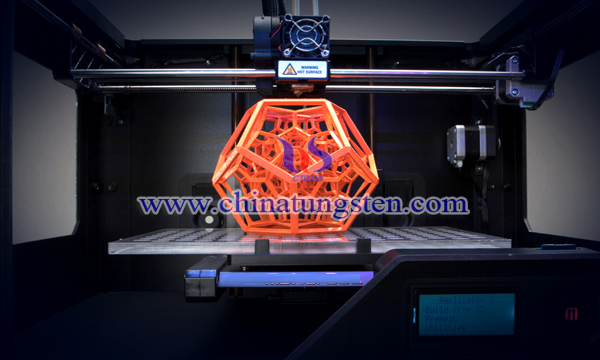New 3D Printing that Is Able To Make Tungsten Parts
- Details
- Category: Tungsten Information
- Published on Thursday, 19 July 2018 16:47
3D printing technology is also known as additive manufacturing. The use of this technology to manufacture metal parts is somewhat the same as the traditional powder metallurgy. They both use powder material such as ceramic powders and metal powders. The difference is that the material powder is not joined by sintering, but is formed by using a special adhesive to "print" the cross section of the part onto the material powder.
At present, one of the difficulties of 3D printing technology is to use refractory metal for printing, especially tungsten, chromium and bismuth, nor the nano-sized powder material. Over the years, scientists from all over the world have worked on new processes that can be cost-effective and achieve the desired performance requirements.

Lately, scientists had developed a new technology that could create complex nanoscale metal parts with 3D printing technology. This technology can be used in a variety of applications. For example, it can be used to build a 3D logic circuit on tiny computer chips, manufacturing engineering ultralight aircraft components, and to create nanomaterials with a variety of characteristics.
In 3D printing, objects are built layer by layer. It allows the manufacture of parts without conventional subtractive methods such as etching or milling. Julia Greer, a materials scientist at the California Institute of Technology, and her team designed an ultra-thin 3D architecture in the 3D printer group (additive manufacturing machine). The three-dimensional architecture is nanoscale, which is too small to be visible to the naked eye.
The new 3D print process is able to print a structure made of various materials, from ceramics to organic compounds. In addition, scientists are also working hard to break through 3D printing of refractory metals like tungsten and titanium, especially when trying to make fine powders that are less than about 50 microns in size or about half the width of the hair.
More specific description: Scientists bind nickel and organic molecules together to form a liquid that looks like syrup. They used computer software to design a structure and then built it by switching the liquid with a two-photon laser. Lasers create stronger chemical bonds between organic molecules and harden them into building blocks. Since these molecules also bind to nickel atoms, nickel will bind to the structure. In this way, the team was able to print a three-dimensional structure that was originally a mixture of metal ions and non-metallic organic molecules.
The structure is then placed in an oven and slowly heated to 1000 degrees Celsius (about 1800 degrees Fahrenheit) in vacuum. This temperature is much lower than the melting point of nickel (1455 degrees Celsius or about 2650 degrees Fahrenheit), but is hot enough to evaporate the organic material in the structure, leaving only the metal. A heating process called pyrolysis also fuses the metal particles together.
In addition, since the process evaporates a large amount of structural material, its size is reduced by 80%. But its shape and proportion are maintained. The ultimate shrinkage is an important reason why the structure can be made so small. In this constructed nanostructure, the diameter of the metal beam of the printed portion is approximately 1/1000 of the size of the tip of the needle. ”
Greer and her team are still improving their technology, and although they started with nickel, they are interested in expanding to other metals commonly used in the industry, such as tungsten and titanium. At the same time, scientists also hope to use this process to print other materials, including ceramics, semiconductors, piezoelectric materials and other dissimilar materials.
- Tungsten Manufacturer & Supplier, Chinatungsten Online: www.chinatungsten.com
- Tungsten News & Prices of China Tungsten Industry Association: www.ctia.com.cn
- Molybdenum News & Price: news.molybdenum.com.cn
- Tel.: 86 592 5129696; Fax: 86 592 5129797; Email: sales@chinatungsten.com



 sales@chinatungsten.com
sales@chinatungsten.com